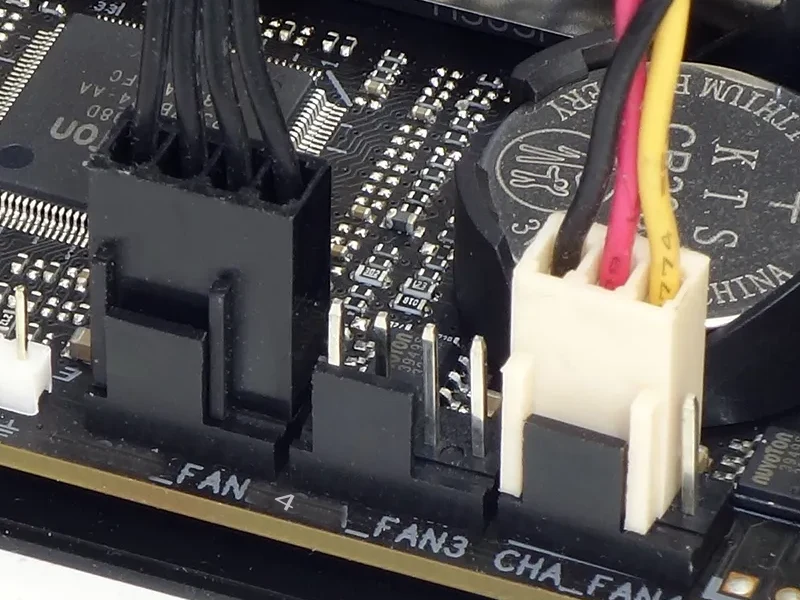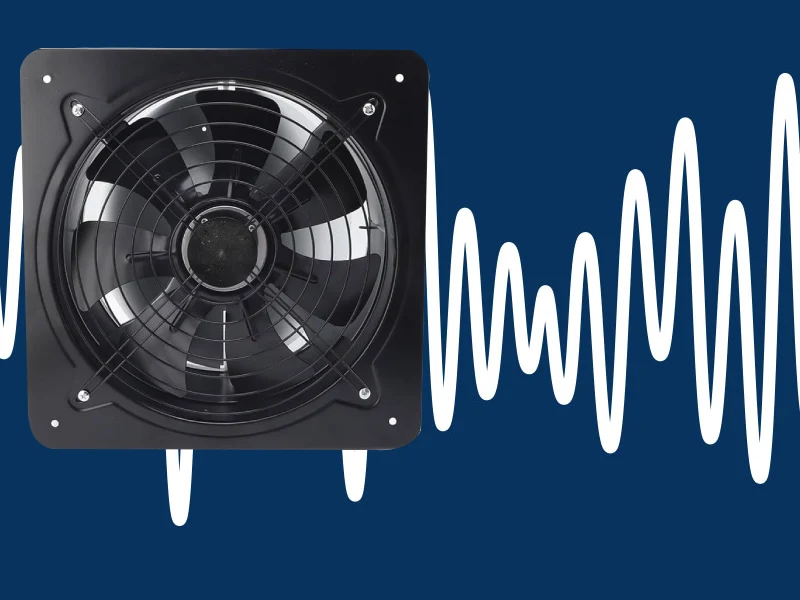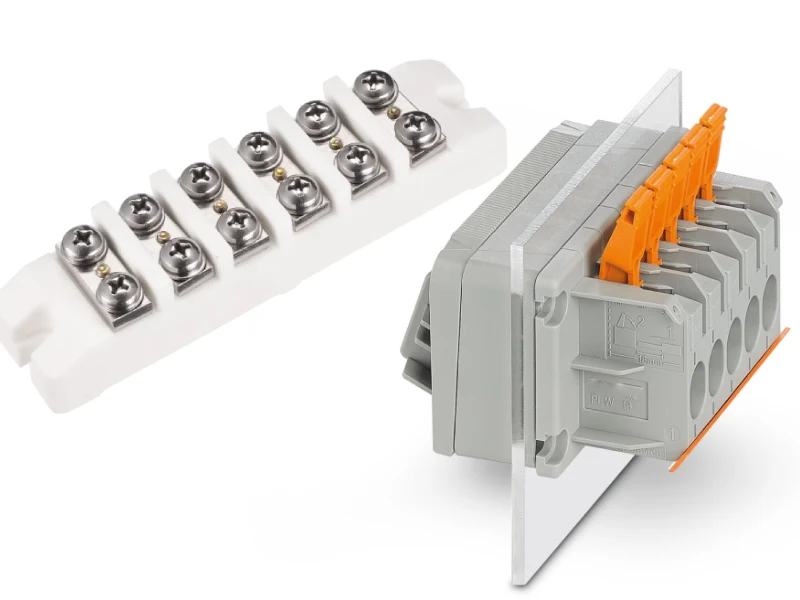To ensure the safety of your outdoor electrical connections in 2025, it’s essential to know How to Weatherproof Outdoor Electrical Connections effectively. Leading solutions include Linkewell’s Outdoor Enclosure, Enclosure Heater, and electrical power distribution box, all designed to provide superior protection. Many professionals also recommend IP68 waterproof connectors for their exceptional durability and defense against the elements. Waterproof sockets and enclosures are built with robust materials to withstand rain, dust, and extreme temperature fluctuations. Choosing advanced waterproofing solutions is crucial for maintaining reliability in harsh environments. When considering How to Weatherproof Outdoor Electrical Connections, always select products that meet rigorous certifications and have been proven in real-world applications.
Key Takeaways
- Pick waterproof connectors and enclosures with high IP ratings like IP65 or higher. These protect outdoor electrical connections from water and dust.
- Use Linkewell’s Outdoor Enclosure and Enclosure Heater for strong protection. They are certified and keep equipment safe from rain, dust, and temperature changes.
- Install waterproof products with care. Clean the area first. Seal gaps with silicone or tape. Check the seals often to make sure they last.
- Choose materials like stainless steel or polycarbonate for your environment. These materials resist rust, UV rays, and bad weather.
- Check outdoor electrical parts often for damage or moisture. This helps stop failures and keeps your system safe and working well.
Top Waterproofing Solutions
You have many ways to keep outdoor electrical connections safe. The best choice depends on where you live and what equipment you use. You also need to think about how long you want the protection to last. Here are some top picks for 2025. These include advanced waterproof connectors, waterproof cable connectors, and Linkewell’s enclosures and heaters.
Best Waterproof Connectors
Waterproof connectors help keep outdoor electrical systems safe. Look for connectors with high IP ratings and strong seals. They should also resist rust. Many top connectors use gold-plated contacts and special gaskets. These parts block water and dust. They work in hot and cold weather. Some connectors are made for tough jobs and last a long time.
Here is a table that compares the best waterproof connectors for 2025:
| Connector Model | IP Rating | Temperature Range | Certifications / Standards | Key Features |
|---|---|---|---|---|
| Neutrik etherCON | IP65 with cover | -20°C to +65°C | N/A | Gigabit speed, EMI shielding, XLR-style lock |
| Deutsch DT04-12P | IP68 | -55°C to +125°C | Military-grade | Wedge-lock coupling, 25A per contact |
| Souriau 8STA Series | IP68/IP69 | -65°C to +175°C | MIL-DTL-38999 compliant | Hermetic sealing, 60A max, military spec |
| LEMO K Series | IP68 | -55°C to +200°C | N/A | Self-latching, 360° EMI shielding |
| Harting Han 3A Series | IP68 | -40°C to +125°C | N/A | Hot-swappable modules, lever coupling |
| Weidmüller OMNIMATE | IP67 with housing | -40°C to +100°C | N/A | Tool-free connection, space-saving design |
| Bulgin Buccaneer Series | IP68/IP69K | -40°C to +80°C | N/A | Bayonet coupling, corrosion-resistant materials |
| ODU MINI-SNAP L Series | IP68 | -40°C to +120°C | N/A | Break-away design, compact size |
Tip: Check for certifications like UL, CSA, and ATEX. These show the connector is safe and high quality.
Waterproof Cable Connectors for Outdoor Use
Waterproof cable connectors keep water and dust out. They need to handle shaking, pulling, and bending. Good connectors have silicon flanges and locks. These last longer than simple O-ring seals. They also do well in salt and stress tests. This makes them great for tough outdoor places.
Radiall waterproof RF connectors have an IP68 rating. They work from -40°C to +105°C. You do not need extra boxes for them. They can be used many times. Labs test these connectors to meet standards like IEEE, UL, and TIA/EIA. This means you can trust them to last.
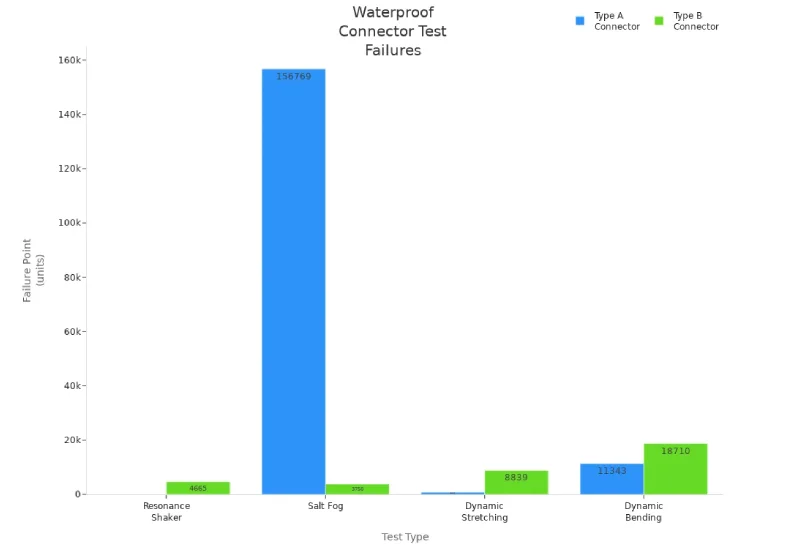
Note: It is important to put connectors together the right way. Even the best ones can fail if not installed right. Always follow the instructions.
Linkewell Outdoor Enclosure and Enclosure Heater
For the best protection, use Linkewell’s Outdoor Enclosure and Enclosure Heater. These keep your electrical parts safe from rain, dust, and heat or cold. The Outdoor Enclosure has UL, CE, and NEMA certifications. It is made from stainless steel or other strong materials. It has IP66 or NEMA 4X ratings. You can pick the size, material, and extras you need.
The Enclosure Heater keeps the inside warm. It stops water from forming inside. This protects your electronics from wet and cold. The heater uses smart heating to save energy. It helps your equipment last longer. You can choose different power levels and ways to mount it. Both products meet strict world standards and last a long time.
| Scenario | Solution Description | Customer Value/Benefit |
|---|---|---|
| Telecom Base Stations | Maintains 5G signal stability at temperatures as low as -30°C | Reduces downtime and maintenance costs |
| Industrial Control | Keeps PLCs and inverters at constant temperature | Enhances production line continuity |
| Data Centers | Prevents condensation on servers | Avoids costly data loss and operational risks |
You can count on Linkewell for fast shipping, tech support, and custom options. These products help you save money and avoid problems.
Other Leading Waterproofing Products
You can also use sealants and tapes for more protection. Some brands have liquid membranes, sheet membranes, and special coatings. These can last 10 to 25 years. How long they last depends on the type and care.

Always pick products with the right IP or NEMA rating. This helps them work better and last longer.
Why Waterproofing Matters
Safety and Reliability
Waterproofing outdoor electrical connections keeps them safe and working. Water can make wires short out or rust. Sometimes, it can even start fires. Using waterproof outlet covers with gaskets and seals blocks rain and snow. These covers stop water from getting to your outlets. This lowers the chance of things breaking or catching fire. Waterproof connectors with high ingress protection ratings keep out water and dirt. This helps your equipment work better and last longer.
Checking your outdoor electrical parts often helps you find water or rust early. This keeps your protection strong and makes sure things work for a long time.
Some waterproof covers have GFCI protection. This shuts off power if there is a ground fault. It makes your outdoor areas safer. You can also make things more reliable by putting outlets higher than flood levels. Sealing entry points helps too. These steps help you save money and avoid problems.
Common Outdoor Hazards
Outdoor electrical systems face many dangers. Water getting in is a big problem. Here are some common issues you might see:
- Gaskets that are not tight enough can let water leak in.
- If covers are missing, water can get into outlets.
- Strong sprays or jets can push water into enclosures.
- When the air pressure inside drops, water can get pulled in.
- If cable entry points are not sealed, water can seep inside.
- Not enough venting or drainage lets water build up.
- Using parts without the right IP rating gives less water protection.
- Bad sealing at junctions or connectors can cause rust and shorts.
You can make your system last longer by picking the right waterproof products. Installing them the right way is important. Outdoor protection starts with using enclosures and connectors made for tough weather. When you do these things, your equipment stays safe and works well for a long time.
Types of Waterproofing Products
If you want to keep outdoor electrical systems safe, you need to know about waterproof products. Each type has special features for blocking water and sealing. Here are some things to look for:
Waterproof Cable Connectors
Waterproof cable connectors help stop water from getting in. They use rubber or silicone seals to block water. There are screw free and screw types for tough outdoor jobs. You can use them with marine equipment, solar panels, and pool systems. Many have IP68 ratings, so they work even under water for a long time. Always check the seal and make sure the connectors fit tight.
Tip: Make sure you connect waterproof cable connectors the right way. This keeps the waterproof rating strong.
Connector Waterproof Plugs
Connector waterproof plugs give extra safety for outdoor connections. These plugs use gaskets and layers to keep out water and dust. They also protect against rust. Many plugs are made from polycarbonate or stainless steel. Locking parts and gold-plated contacts keep the connection steady. You can use these plugs for outdoor lighting, energy storage, and transportation. The table below shows some top choices:
| Brand/Series | Waterproof Rating | Key Features | Typical Use |
|---|---|---|---|
| Omnetics Quick Lock USB 3.0 | IP67 | Sealed housing, rugged, lightweight | Harsh environments |
| Intelliconnect Pisces Range | IP67, IP68 | Hermetically sealed, unmated proof | Marine, oil & gas, SCADA |
| Amphenol Sine ecomate Aquarius | IP67, IP69K | Quick bayonet, high-impact plastic | Industrial, outdoor |
| Souriau UTS Series | IP68, IP69K | Extreme sealing, audible click | Power, mining, telecom |
Enclosures and Heaters by Linkewell
Linkewell’s Outdoor Enclosure and Enclosure Heater give the best waterproof protection. The enclosures have high IP ratings and strong seals. They keep your electrical parts safe from rain, dust, and big temperature changes. The heaters use PTC technology and thermostats to save energy and keep things dry inside. You get less water inside and fewer problems. These products work well in substations, cabinets, and outdoor automation systems.
Customers say Linkewell heaters cut failures in outdoor cabinets by up to 80%.
Sealants and Tapes
Sealants and tapes add more waterproof safety. You can use butyl, vinyl, or silicone-based tapes to seal gaps and joints. These tapes stick to metal, plastic, and concrete. Butyl tape is sticky and bends easily. Polyurethane tape lasts longer and handles weather better. The table below compares popular options:
| Brand | Type | Key Strengths | Temp Range |
|---|---|---|---|
| ASLONG | Butyl Tape | Superior adhesion, flexible, UV proof | -40°C to +90°C |
| 3M | Vinyl Electrical | Strong insulation, weather resistant | -18°C to +105°C |
| Tesa | Silicone Tape | Bonds to itself, wide temp range | -60°C to +260°C |
| Denso | Petrolatum-based | Corrosion resistance, underwater use | -15°C to +55°C |
Pick sealants and tapes that fit your outdoor area and how much water protection you need.
How to Weatherproof Outdoor Electrical Connections

Step-by-Step Guide
Here are steps to help you weatherproof outdoor electrical connections and keep them safe:
- Get all materials that are made for outdoor use. You need weatherproof conduit, connectors, cable glands, and enclosures like Linkewell’s Outdoor Enclosure.
- Always turn off the power before you start. This keeps you from getting hurt.
- Wipe the connector housing with a damp rag. Clean off any dirt or dust.
- Connect the wires as needed. Use the right tools to tighten all connectors.
- Put silicone sealant or self-fusing silicone tape on open spots. Let it dry or fuse so it keeps water out.
- For more safety, use adhesive-lined heat shrink tubes. Heat them until they shrink and stick to the connection.
- Put weatherproof covers or bubble covers on outlets. These covers block rain and snow.
- If you bury cables, fill the trench with sand or put caution tape above the conduit.
- Check your work. Make sure all seals are tight and covers are on.
- Turn the power back on and test if everything works.
Tip: Always follow local rules and ask an expert if you are not sure. Check your setup often to find problems early.
Choosing the Right Product
To weatherproof outdoor electrical connections, you need to pick the right waterproof product. Think about these things:
- Rain and moisture: Use enclosures with high IP ratings, like IP66 or higher, for strong protection.
- UV radiation: Pick materials that resist UV, such as polycarbonate or coated aluminum.
- Temperature extremes: Choose products that can handle both hot and cold. Use heaters or insulation for extra safety.
- Corrosion resistance: In coastal or factory areas, stainless steel or aluminum is best.
- Material selection: Pick between plastics and metals based on where you live.
- Design features: Look for tight seals and strong fasteners.
- Maintenance: Check seals and covers often to keep them working well.
- Product quality: Buy from trusted brands like Linkewell for good results.
- Match the product to your electrical needs. Check the current, voltage, and how you will install it.
- Proper installation: Make sure you put everything in the right way to keep it waterproof.
If you want to pick the right waterproof plug, always check the IP rating and what it is made of. This helps you get the best safety for your outdoor electrical setup.
Comparing Waterproof Connectors and Enclosures
Material and Build
When picking waterproof connectors and enclosures, look at what they are made of. Connectors are often made from strong plastics like polycarbonate or PBT. Some use metals like stainless steel or aluminum with special coatings. These materials help block UV rays, water, and big temperature changes. Metal connectors are good for tough places like factories or near the ocean. They do not rust and last longer. Plastic connectors are lighter and cost less. But they can get weak if left in the sun or heat too long. Enclosures and covers use PVC, PE, and rubber. These materials keep out water and stand up to sunlight and weather. Silicone or rubber gaskets seal the edges. This keeps water out and helps the box last longer.
Installation and Maintenance
To make sure waterproof plugs and connectors work, you must install them right. First, strip the wires to the right length. Put the wires inside the connector and screw or crimp them tight. Place seals and grommets carefully to stop leaks. Test the connection before closing it up. For plugs, always push them together all the way. If you leave them open, water can get in. Check your connectors often for dirt, rust, or damage. Clean them and tighten screws to keep the seal strong. Replace broken plugs right away. For enclosures, check the seals and gaskets every 6 to 12 months. If you open the box, reseal it and change any worn gaskets to keep things safe.
Tip: Checking your plugs and connectors often helps them work better and last longer.
Cost and Value
Good waterproof connectors and enclosures cost more because they meet strict rules. You pay more for strong protection from water, dust, and accidents. This higher price means your equipment works better and lasts longer. Good enclosures protect your electronics, so you do not have to pay for repairs. You can save money by picking standard boxes instead of custom ones. Buying from trusted brands like Linkewell gives you fast shipping and products you can trust. When you buy good quality, you get peace of mind and strong outdoor electrical systems.
Understanding IP Ratings
What IP Ratings Mean
When you choose outdoor electrical products, you often see IP ratings on the label. These ratings help you know how well a product can keep out dust and water. You need to understand what each part of the rating means so you can pick the right waterproof solution.
- IP ratings use two numbers. The first number shows how much protection the product gives against solids like dust or sand. The second number shows how well it keeps out water.
- The first digit goes from 0 (no protection) to 6 (dust-tight). The second digit goes from 0 (no protection) to 9K (protection against high-pressure water).
- Higher numbers mean better protection. For example, IP67 means the product is dust-tight and can handle being under water up to 1 meter for 30 minutes.
- Some connectors keep their IP ratings even when not plugged in, which helps them last longer outdoors.
- You should always check the IP ratings before you buy outdoor electrical products. This helps you avoid problems from rain, dust, or even cleaning with water jets.
Tip: IP ratings follow the IEC 60529 standard. This makes it easy to compare different products.
Recommended Levels
You want to pick the right IP rating for your outdoor electrical connections. The best level depends on where you use the product and how much water or dust it will face. Here is a table to help you understand the most common IP ratings for outdoor use:
| IP Rating | Solid Ingress Protection | Liquid Ingress Protection |
|---|---|---|
| 3 | Objects > 2.5mm (small gravel) | Water spray up to 60° angle for 5 minutes |
| 4 | Objects > 1mm (large sand) | Water spray from any direction for 10 minutes |
| 5 | Dust protected | Water jets at 4.4 psi from 3 meters for 3 minutes |
| 6 | Dust tight | Powerful water jets at 15 psi from 3 meters for 3 minutes |
| 7 | N/A | Immersion up to 1 meter for 30 minutes |
| 8 | N/A | Immersion beyond 1 meter (as specified by manufacturer) |
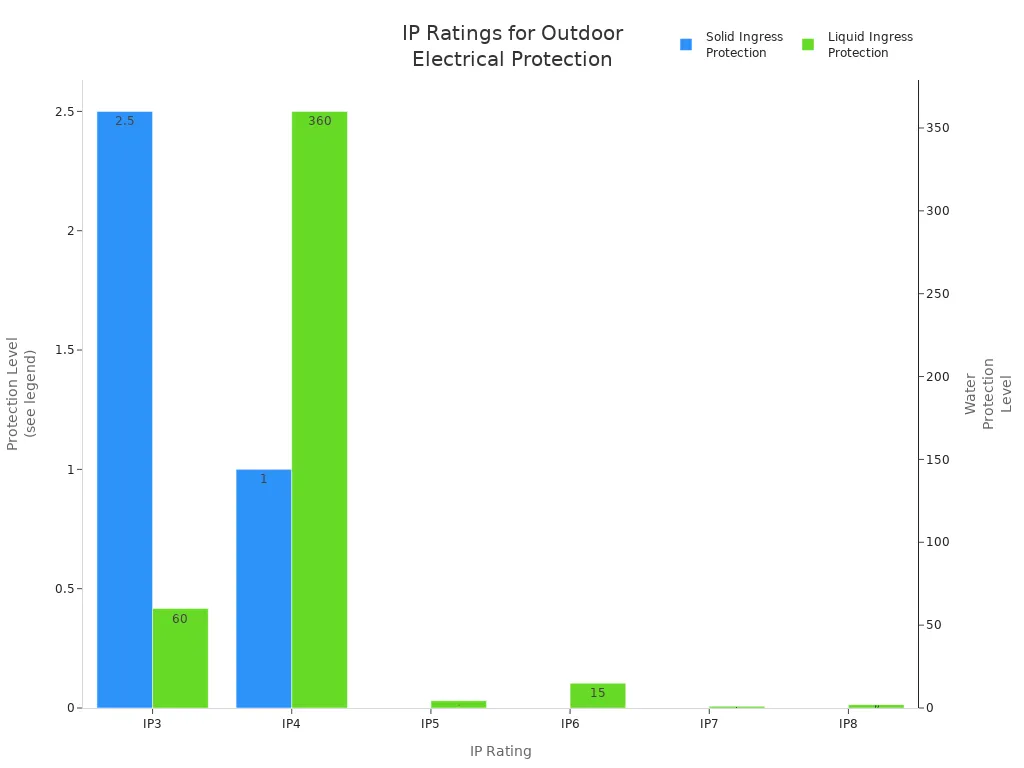
For most outdoor electrical connections, you should look for at least IP54. This gives you some dust protection and keeps out water splashes. If you want stronger waterproof protection, choose IP65 or higher. IP65 protects against dust and low-pressure water jets, which is great for outdoor lighting or exposed outlets. For places with heavy rain or possible flooding, IP67 or IP68 is best. These ratings protect your equipment from full immersion in water.
Note: Always match the IP rating to your environment. If you use Linkewell’s Outdoor Enclosure, you get IP66 or higher, which means strong protection for your outdoor electrical systems.
Product Comparison Table
Features at a Glance
When picking a waterproofing solution, you want to know how each one works. The table below shows the most important features. You can use it to compare products and choose what fits your needs best.
| Feature / Metric | Details |
|---|---|
| IP Ratings | IP65 keeps out dust and water jets. IP68 can go underwater. These are the best choices. |
| Connector Types | There are screw-on, bayonet, push-pull, twist-lock, lever, and 3-way connectors. |
| Material & Durability | Rubber or silicone seals, strong plastics, polycarbonate, PBT, stainless steel, and aluminum are used. |
| Installation & Maintenance | Tool-free or quick-lock designs make setup easy. Checking seals often keeps them working. |
| Electrical Performance | High current and voltage ratings. Gold-plated contacts help electricity flow better. |
| Environmental Resistance | These resist UV rays and rust. They work in hot or cold weather. |
| Application Suitability | You can use them for boats, factories, outdoor lights, underwater, and tough places. |
| Advanced Features | Some have sensors and special locks for more safety. |
Top waterproof connectors keep their IP Ratings even when unplugged. They use sealing caps or dust covers. Strong materials like polycarbonate and stainless steel help them last longer. Gold-plated contacts stop rust and keep power moving. Locking systems like push-pull or bayonet locks keep the connection tight.
Tip: Look for certifications like UL, ISO, or CE. These show the product is safe and high quality.
You can use these products in many places. Outdoor lights, boat electronics, and factory machines all need good waterproofing. If you want the best, Linkewell’s Outdoor Enclosure is a great pick. It has high IP Ratings, strong materials, and is easy to install. You get peace of mind and it lasts a long time.
Selection Checklist
Assessing Your Needs
Before picking a waterproofing solution, think about your project’s needs. Use this checklist to help you make a good choice:
- Environment: Does your area get lots of rain or dust? Is there salt in the air or very hot or cold weather?
- Application: What do you need to protect? It could be outdoor lights, telecom gear, or control panels.
- IP/NEMA Rating: Pick the right protection level. For most outdoor jobs, IP65 or higher is best.
- Material: Do you need stainless steel to stop rust? Fiberglass does not conduct electricity. Polycarbonate is strong if things might get hit.
- Size and Layout: Measure your space. Make sure the enclosure fits your equipment and cables.
- Climate Control: Will you need heaters, fans, or air conditioners? These help if it gets very hot, cold, or wet.
- Security: Do you need locks or tamper-proof parts for extra safety?
- Maintenance: Plan for easy checks and repairs.
Tip: Write down your answers. This helps you talk to suppliers and get the right product.
Linkewell Support and Customization
Linkewell gives expert help and many choices. You can pick from outdoor enclosures and waterproof junction boxes. Choose stainless steel, fiberglass, or polycarbonate. Each one works best in different places. Linkewell’s products have high IP and NEMA ratings. This means they protect well from water, dust, and bumps.
You can add gaskets, seals, or coatings for more weatherproofing. For security, you can get keyed or electronic locks, tamper-proof screws, and hidden hinges. For climate control, Linkewell has cabinet air conditioners, enclosure heaters, fans, and thermostats. You can also change the size, add cable cutouts, pick how to mount it, and choose vents or cable glands.
- Linkewell helps you at every step:
- Advice before you buy and help with your needs
- Custom design and making your product
- Careful packing and special shipping
- Support after you buy and help with problems
Linkewell has over 20 years of experience. They have big certifications like UL, CE, and ROHS. You can trust Linkewell for safe outdoor electrical protection.
You need to pick waterproofing solutions that fit your area. Experts say to look at how much sun and water your setup gets. Using strong materials helps keep things safe outside. Linkewell is a good choice because it has world certifications and helpful support. Use the checklist to see what you need and ask Linkewell for advice. You can also check expert lists or talk to specialists for more help.
FAQ
What is the best way to protect outdoor electrical connections?
You should use a good outdoor enclosure like Linkewell’s. This keeps water, dust, and dirt away from your electrical parts. It helps your system work safely and last longer.
How do I choose the right IP rating for my outdoor enclosure?
Look at your area. If you get lots of rain or dust, pick IP66 or higher. This rating blocks water jets and dust. Linkewell’s Outdoor Enclosure gives strong protection for most outdoor needs.
Can I install an outdoor enclosure by myself?
You can put in many enclosures by yourself if you follow the steps. Always turn off the power first. If you are not sure, ask a professional for help to stay safe.
Why do I need an enclosure heater for outdoor electrical boxes?
An enclosure heater keeps the inside dry and safe. It stops moisture and condensation from building up. This helps you avoid rust and short circuits, especially when it is cold or wet.
Does Linkewell offer custom sizes or features for enclosures?
Yes! You can ask Linkewell for special sizes, materials, and extra features. This helps you get the best fit for your project. You also get expert advice and quick support.
Conclusion
You want your outdoor electrical connections to be safe and last longer. Using Linkewell’s Outdoor Enclosure gives strong protection from water, dust, and bad weather. You can pick custom options for your project. If you need help, Linkewell’s team gives expert advice and fast support. Trust Linkewell for reliable, certified solutions. Click now to ask about custom enclosures or get a quote for your next project.

